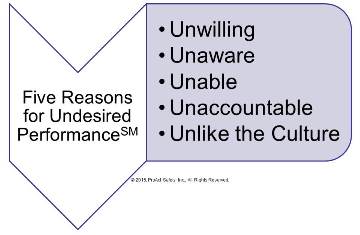Five Reasons You Have Undesired Performance
If people are unaware of what they need to do or how they need to do it, we must ensure communication is clear and both performance and results based.
Leaders set expectations and manage the influences on them, but some spend too much time managing displeasing results. No effective leader can truly expect perfect performance from every one of their direct reports, one hundred percent of the time. Those who have unrealistic expectations misunderstand human behavior and its influences and likely create undesirable work environments. Managing, coaching, or counseling undesired performance is an integral part of any leader's responsibilities. How is this handled in your organization?
Human resources is too often used as a disciplinary crutch. Training departments are engaged to communicate information to change behavior, which is expected to somehow magically result in the desired outcomes. Accountability is used more as a response to poor results: "We didn't get the results we wanted. Who needs to be held accountable for this?!" Rather, accountability should be used as a positively-viewed tool to proactively shape both behavioral and results expectations. Culture, an increasingly frequent topic among boardroom discussions, is looked upon as the next step-change opportunity.
All these departments, tools, and topics have merit when performance improvement considerations are explored, but which one is the best tool for the job? People do things for a reason. If you do not understand the reason, your efforts to change behaviors and results will be unsuccessful or limited, at best.
A five-part model was developed for client organizations to increase the effectiveness of how they manage influences on desired and undesired performance. These are explored below.

Unwilling – All organizations will eventually change, evolve, restructure, refocus, downsize, rightsize, brightsize, merge, or align. Not everyone will want to remain on board or support the new direction. All employment is a behavioral rental agreement. If someone is not willing to do what is expected of them, sometimes deselection is the necessary approach.
Unaware – When expectations are shared, it is typically the necessary results that are communicated, leaving it to the individual to ascertain how best to achieve them. If people are unaware of what they need to do or how they need to do it, we must ensure communication is clear and both performance and results based. Communication is more about verifying knowledge transfer than confirming you were heard. Certainly autonomy is desired and micromanaging is not. Sometimes, however, the way things are accomplished is most important. Further, for successful organizations, clear responsibilities are necessary to fulfill certain roles. Responsibilities are best behaviorally defined. How well are these understood?
Unable – If someone lacks either the skills or confidence or something limits or creates barriers to their performance, we must enable them. Sometimes enabling comes in the form of training, or sometimes coaching is used to build competence and confidence. These will be limited, however, in yielding value if something is standing in the way. Imagine an inaccessible tool.
Unaccountable – True accountability is making sure people are doing what is necessary to accomplish the results, prior to verifying results. Effective accountability has two sides: proactive and reactive. Proactive accountability looks at ensuring the behaviors are desirable; reactive accountability looks at the results. Both require a balance of consequences to shape performance. What happens when people do what is necessary? What happens when they do not? What happens when we get the desired results, and what happens when we don't?
Unlike the Culture –When a newly on-boarded employee or contractor is later exposed to the masses who say, "Let me show you how we really do it around here," it is a powerful force sure to shape decisions and behavioral choices. Culture is what is common among a group of people, both between their heads (i.e., beliefs) and across their behaviors. If the expected behaviors of the individual’s leader is not like what is commonly observed by peers and other levels within the organization, the leader is soon to be disappointed.
Prior to reacting to misalignments with expectations, invest time in understanding the reason. We must think strategically about how we will achieve the desired results and, when necessary, deal with undesired performance. Strategy is a framework of choices, tradeoffs, or bets the organization makes to determine how to capture and deliver sustainable value over time. Strategy, therefore, is: How do we win? Sustainable value in this situation is dependable and repeatable performance and results. This only comes from an approach proactively focused on understanding and overcoming these powerful influences on employee performance before they become a problem.
This article originally appeared in the November 2015 issue of Occupational Health & Safety.